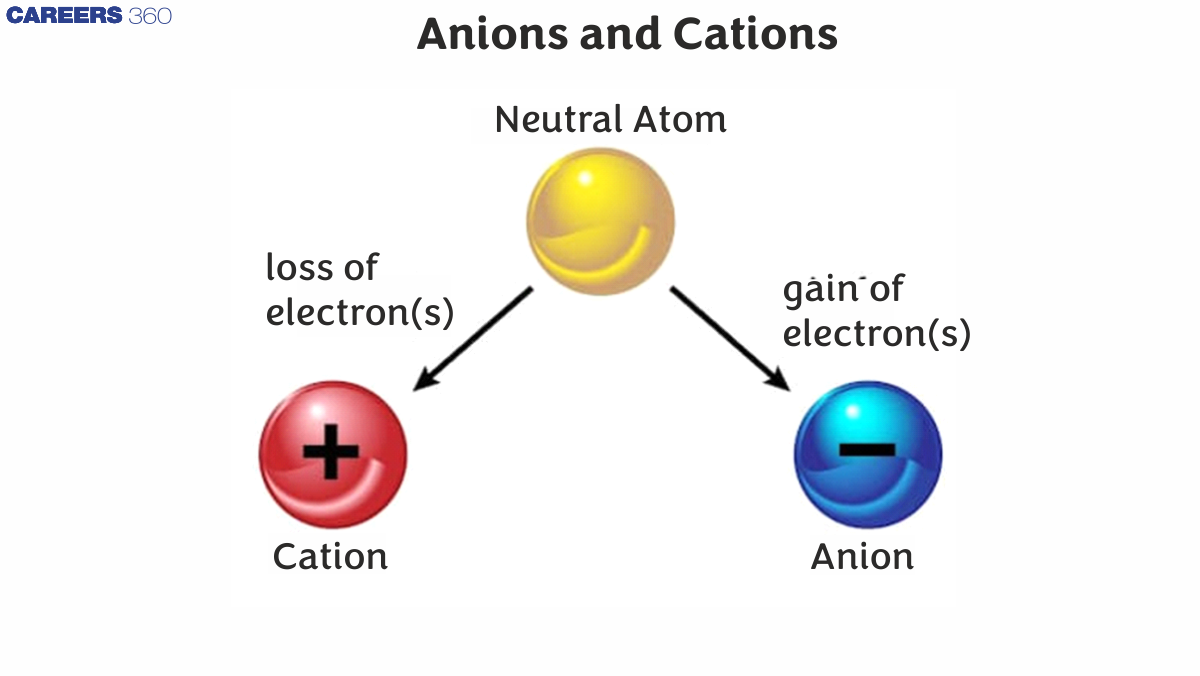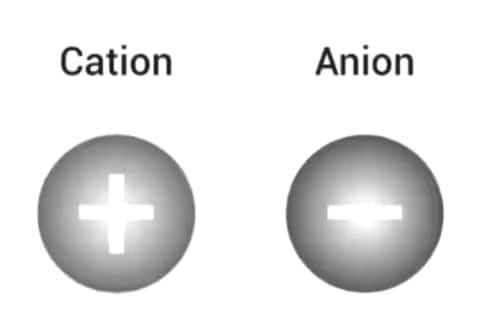Anions and Cations Difference - Meaning, Example, Types, Uses, FAQs
Atoms become charged when they gain or lose electrons, forming ions. These ions are of two types: cations and anions. Atoms and electrons are those that can gain or lose one valence electron from ions. The ion formed after the gain of an electron is called an anion, and the ion that forms after the loss of an electron is called a cation. The anion carries the negative charge, and the cation carries the positive charge. A cation is smaller in size than an anion.
This Story also Contains
- Cation
- Anion
- Cation vs Anion
- Difference Between Cations and Anions
- Uses of Cations and Anions
- Some Solved Examples

In this article, we will learn about the ions, cations, and anions, their differences, along with some solved examples.
IONS
Ions are entities studied in science. Chemistry is made up of atoms and electrons that have gained or lost weight as a result of the removal or addition of one or more valence electrons, resulting in a positive or negative charge. Negative charge-bearing ions are known as anions, whereas positive charge-bearing ions are known as cations. Due to the fact that they both have charges of opposing characteristics, they are attracted to one another and create an ionic connection.
The word ion comes from the Greek word ἰόv, which means "to travel." Ions are electrically charged particles. An ion is an atom or molecule with a positive electric charge. Because the number of electrons and protons in an atom is equal, they have no charge and are neutral in nature. While the amount of protons in ions is identical, the number of electrons is unequal. As a result, they are either positive or negative ions.
Examples of ions include$\mathrm{Na}^{+}, \mathrm{O}^{-2}, \mathrm{NH}_4^{+}, \mathrm{OH}^{-}$, and others.
Polyatomic ions are a group of elements or atoms that are covalently connected but have either a positive or negative charge. Polyatomic ions include $\mathrm{CN}^{-}, \mathrm{OH}^{-}, \mathrm{NH}_4^{+}, \mathrm{NO}_3^{-}, \mathrm{CO}_3^{-2}$, and others. Monoatomic ions are ions that have only one element and have either a positive or negative charge. Examine $\mathrm{Na}^{+}, \mathrm{O}^{-2}, \mathrm{Al}^{+3}, \mathrm{Ce}^{+3}$, and so on.
Related Topics
Cation
The ions with a positive charge are referred to as cations. Examples of Cations include Na+, Al+3, Ce+3, and so on. When an atom loses an electron, it obtains a positive charge because its nucleus has fewer electrons than protons. The positively charged species is then referred to as a cation. Faraday and Whewell coined the phrase. It is derived from the Greek words (káto) ἰόv,, and (kation), both of which indicate “going down”.

Also, check-
Anion
The ions with a negative charge are known as anions. Examples of Anions include O-2, CN-, OH-, Cl-, and others. When an atom gains electrons to achieve stability, it acquires a negative charge because its nucleus contains more electrons than protons. This negatively charged species is therefore referred to as an anion charge. Faraday and Whewell coined the phrase. It comes from the Greek word ἄvω ἰόv (anion) meaning “going up” Positive ions are called anions.
Cation vs Anion
Positively charged ions are known as cations. Negatively charged ions are known as anions. Ions are positively or negatively charged atoms or molecules. A balanced atom will become a positively charged cation if one or more electrons are lost.
How to use Cation vs Anion-Remember that cations are positive ions, meaning they have lost one or more electrons and hence have more protons than electrons. Anions are negatively charged ions because they have acquired one or more electrons and so have more electrons than protons(cation vs anion).
Difference Between Cations and Anions
The Major Difference Between an Anion and a Cation in Terms of Charge, Nature of the Element, and the Electrode are given as:
|
Basis |
Anions |
Cations |
|
Definition |
An anion is an atom or molecule that is negatively charged. |
A cation may be defined as an atom or molecule that is positively charged. |
|
Charge Type |
Negative |
Positive |
|
Type of Element |
Non-Metal |
Metal |
|
Type of Electrode used |
Anode |
Cathode |
|
Examples |
Sulfide, Oxide, Fluoride, Chloride |
Iron, Lead, Sodium |
The above table shows the difference between cation and anion(cation vs anion).
|
Related Topics |
Anions and Cation can be Distinguished from one Another as:
|
S.No |
CATION |
ANION |
|
|
A cation is an ion or a charged particle with a positive charge |
An anion is an ion or a charged particle with a negative charge. |
|
|
The word cation comes from the Greek word (káto) (kation), which means "to go down." |
The word anion comes from the Greek word ἰόv (anion), which means "to rise." |
|
|
The number of protons in cations is greater than the number of electrons |
The number of electrons in anions is greater than the number of protons. |
|
|
Metals, in general, create cations. |
Non-metals, in general, form anions. |
|
|
In electrolysis, cations are drawn to the negatively charged electrode. |
In electrolysis, anions are drawn to the positively charged electrode. |
|
|
Anions are larger than cations, whereas cations are smaller. |
Anions are often larger than cations in size. |
|
|
Cations gain electrons and become neutral atoms or molecules as a result. |
Anions lose their electrons and become neutral atoms or molecules. |
|
|
Ionic compounds are formed when cations and anions create electrostatic or ionic connections |
Ionic compounds are formed when anions create electrostatic or ionic connections with cations |
|
|
Cations include $\mathrm{Na}^{+}, \mathrm{Mg}^{+2}, \mathrm{Ca}^{+2}, \mathrm{Fe}^{+3}$,, and so on. |
Anions include $\mathrm{O}^{-2}, \mathrm{Cl}^{-}, \mathrm{Br}^{-}$, and others. |
Uses of Cations and Anions
In our daily lives, cations play a crucial function. Blood pressure regulation and muscular contraction are both dependent on sodium, potassium, and magnesium ions. Calcium ions are a crucial component of bone structure. Water softeners can use sodium ions to eliminate other hazardous elements.
Anions are negatively charged ions that are generated when electrons outnumber protons in atoms or molecules. Anions and cations frequently interact to form salts, which are essential in the human body. From Hormones production to DNA construction, these particles are involved in a variety of important biological activities.
Also read -
Some Solved Examples
Question 1: When a sodium atom forms a sodium ion, it:
A) Gains one electron
B) Loses one electron
C) Gains one proton
D) Shares one electron
Solution:
Sodium $(\mathrm{Na}) \rightarrow \mathrm{Na}^{+}+\mathrm{e}^{-}$
It loses one electron to achieve the stable configuration of neon $(2,8)$. Hence, $\mathrm{Na}^{+}$is a cation.
hence, the correct answer is option (B)
Question 2: Which of the following pairs represents a cation and an anion respectively?
A) $\mathrm{Na}^{+}$and $\mathrm{Cl}^{-}$
B) $\mathrm{Cl}^{-}$and $\mathrm{Na}^{+}$
C) $\mathrm{O}^{2-}$ and $\mathrm{N}^{3-}$
D) $\mathrm{H}^{+}$and $\mathrm{K}^{+}$
Solution:
Na⁺ is a cation (positively charged), and Cl⁻ is an anion (negatively charged). Together, they form NaCl (ionic compound).
Hence, the correct answer is option (A)
Question 3: The total number of protons and electrons in the ion Ca²⁺ are respectively:
A) 18 and 20
B) 20 and 18
C) 22 and 18
D) 20 and 22
Solution:
$\begin{aligned} & \text { Calcium }(\text { atomic number }=20) \rightarrow \mathrm{Ca}^{2+}+2 \mathrm{e}^{-} \\ & \text {Protons }=20(\text { unchanged }), \text { Electrons }=20-2=18 .\end{aligned}$
Hence, the correct answer is option (B)
Question 4: An ion has 10 electrons and 8 protons. The ion is:
A) Ne
B) $\mathrm{O}^{2-}$
C) $\mathrm{F}^{-}$
D) $\mathrm{Na}^{+}$
Solution:
Oxygen atom (8 protons) gains 2 electrons to form $\mathrm{O}^{2-}$ (10 electrons). Thus, it is an anion.
Hence, the correct answer is option (B)
Frequently Asked Questions (FAQs)
The primary difference lies in their charge: anions are negatively charged, while cations are positively charged. This difference affects how they interact with other ions and molecules.
Anions form when atoms or molecules gain electrons, which can happen through chemical reactions or when atoms attract electrons more strongly due to their electronegativity. Cations form when atoms lose electrons, often due to ionization during reactions or the influence of strong electronegative elements.
The ions with a positive charge are referred to as cations. Cation example include Na+, Al+3, Ce+3 and so on. When an atom loses an electron, it obtains a positive charge because its nucleus has fewer electrons than protons. The positively charged species is then referred to as a cation.
Anions are larger than cations, whereas cations are smaller.
Examples of Cations include Na+,Al+3, Ce
Examples of Anions include O-2, CN-, OH-, Cl-
The word anion comes from the Greek word ἰόv (anion), which meaning "to rise." Also anion is negative.
Ions are electrically charged particles. Negative charge bearing ions are known as anions, whereas positive charge bearing ions are known as cations.